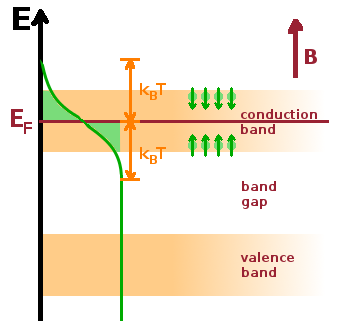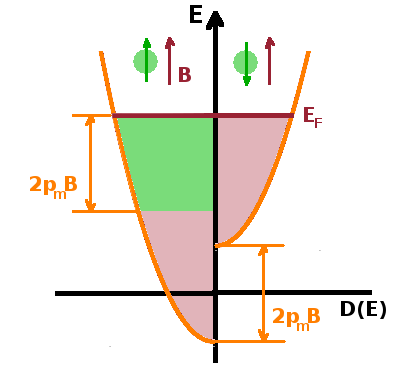

Curie's law states that the susceptibility of a paramagnetic material goes with inverse temperature. This is true for many materials, but in most metals the susceptibility doesn't depend very strongly on temperature. To understand this, we need to see how the band structure influences the magnetisation of a metal sample.

In a metal, the Fermi energy, $E_F$, (the energy of the highest occupied state at absolute zero temperature) lies within an energy band, i.e. the conduction band. The detailed distribution of states within the band is governed by the density of states; here the bands are just shown as rectangular areas in which states are available to be occupied. Different bands are separated by band gaps in which there are no states available. The Fermi distribution (green curve) determines which of the available states will be occupied at a given temperature. At T=0K, the Fermi distribution is a step function with a sharp cut-off at the Fermi energy. As the temperature rises, the curve becomes more inclined, maintaining $E_F$ as a fixpoint - electrons are excited from the green triangle below $E_F$ into the green triangle above $E_F$. The range over which electrons can be excited thermally is of the order of $k_BT$.
In an external magnetic field, the potential energy of those states whose magnetic moments are aligned with the field is reduced by the magnetic interaction energy, and those aligned against the field have a correspondingly higher potential energy. Therefore, the parallel aligned states are nearer the bottom edge of the band. This means that only magnetic moments within a range of $k_BT$ either side of $E_F$ can flip their orientation according to the magnetic field. The 'flippable' fraction is $\frac{k_BT}{E_F}$, and the resulting magnetisation is the usual paramagnetic magnetisation term multiplied by this fraction: $$M_{\textrm{metal}}=\frac{Np_m^2B}{k_BT}\cdot\frac{k_BT}{E_F}=\frac{Np_m^2B}{E_F}\qquad,$$ which is indeed independent of temperature.

The discussion above makes no assumptions about the detail of the density of states within the conduction band. Despite this simplification, it predicts the magnetisation reasonably accurately and demonstrates the fact that the magnetisation of a metal is independent of temperature. We can derive a more accurate formula if we use the density of states according to the free electron gas model of a metal, i.e. treat the delocalised electrons of the atom as independent from the atom cores (nuclei and localised inner-shell electrons) and allow them to move freely like a gas. This model predicts the number $N$ of states per volume element at a particular energy $E$ as $$N(E)=\frac{1}{3\pi^2}\left(\frac{2m_eE}{\hbar^2}\right)^{\frac{3}{2}}\qquad,$$ and thus the density of states $D(E)$ (density here refers to how densely packed the states are on an energy scale) as $$D(E)=\frac{{\rm d}N}{{\rm d}E}=\frac{1}{2\pi^2}\left(\frac{2m_e}{\hbar^2}\right)^{\frac{3}{2}}\sqrt{E}\qquad,$$ represented by the two segments of parabola in the Figure.
When placed in a magnetic field, the potential energy of the parallel and anti-parallel aligned moments is shifted down and up, respectively, by the magnetic interaction $p_mB$, resulting in a relative shift of $2p_mB$ between the parabola segments for the two different orientations. The Fermi energy still applies across the whole electron gas, resulting in a larger population of electrons with parallel aligned moments (in the lowered parabola segment) than anti-parallel ones (in the raised segment). The (anti-)parallel population is $$N_{\uparrow\uparrow,\color{Red}{\uparrow\downarrow}}=\frac{1}{2}\int_{\overset{\color{Red}{+}}{-}p_mB}^{E_F}f(E)D(E\overset{+}{\color{Red}{-}}p_mB){\rm d}E\qquad,$$ where the density of states $D$ has been shifted according to the strength of the magnetic interaction, but the Fermi distribution $f$ remains unchanged since it applies to the electron gas as a whole. The integral consists of a part corresponding to the number of states in the absence of an external field and an almost trapezoidal area (shown in green) near the Fermi energy which is affected by the shift: $$N_{\uparrow\uparrow,\color{Red}{\uparrow\downarrow}}\approx\frac{1}{2}\int_0^{E_F}f(E)D(E){\rm d}E\overset{\color{Red}{+}}{-}\frac{1}{2}p_mBD(E_F)\qquad.$$ The magnetisation arises from the population difference: $$M=p_m(N_{\uparrow\uparrow}-N_{\uparrow\downarrow})=p_m^2D(E_F)B\qquad.$$ The density of states at the Fermi energy $D(E_F)$ in the free electron gas model is $D(E_F)=\frac{3N}{2E_F}$, so the magnetisation becomes $$M_{\textrm{metal}}=\frac{3Np_m^2B}{2E_F}\qquad,$$ confirming the result from the less sophisticated model apart from a factor $\frac{3}{2}$.
Next, we'll see how individual (para-)magnetic moments interact to give rise to much higher susceptibilities in ferromagnets.